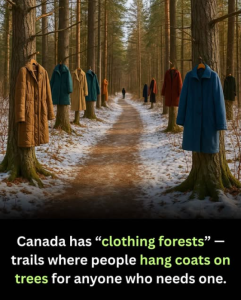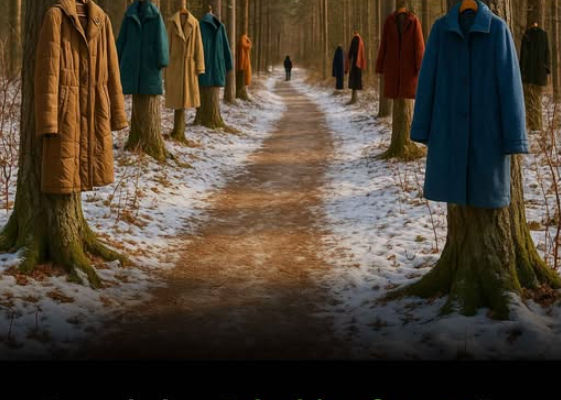
In the heart of Canada’s long, frozen winters, when the air turns sharp and breath steams like smoke, a quiet act of kindness has begun to blossom across the country. From Vancouver’s city parks to the frozen trails of Montreal, trees wrapped in scarves, hats, and coats have begun to appear — not as art installations or decorations, but as lifelines. These are the Winter Forests of Hope, a growing movement where Canadians hang warm clothing in public spaces for anyone in need. There are no donation boxes, no registration lists, no questions asked. Just simple, heartfelt generosity — one piece of clothing at a time.
It started small. In the early 2010s, a woman in Halifax tied a scarf around a lamppost with a note that read, “I am not lost. If you are cold, take me.” The message was simple, but it touched hearts. The image spread online, inspiring others to do the same. Soon, communities from coast to coast began hanging winter clothes in parks, on benches, and along busy streets. Every scarf and mitten became a quiet symbol of compassion — a reminder that even in the harshest cold, warmth can come from one another.
In cities like Winnipeg and Edmonton, where winter temperatures can plummet below -30°C, this small act carries enormous meaning. Volunteers gather donated coats, toques, and gloves throughout the fall, then head out into neighborhoods to tie them to trees or fences with handwritten tags. Some tags carry kind words: “Stay warm, friend.” Others are practical: “For anyone who needs it.” The effect is both emotional and beautiful — streets that might otherwise seem bleak in winter suddenly transform into forests of color, hope, and humanity.
For many struggling through poverty or homelessness, these clothing drops mean survival. Canada’s winters are unforgiving, and shelters often overflow. The Winter Forests of Hope bridge that gap — offering warmth without barriers or bureaucracy. A coat hanging on a tree might not seem like much to someone with a home, but to a person sleeping rough or walking miles in the cold, it can mean the difference between frostbite and comfort, between despair and dignity.
One man in Ottawa described finding a red parka on a snowy morning after weeks of shivering through the nights. “I didn’t have to ask anyone, I didn’t have to explain,” he said quietly. “Someone cared enough to leave it there. That coat felt like love.” Stories like his echo across Canada, each one proving that the smallest gestures can ripple into something far greater.
What makes the movement special is that it’s entirely grassroots. There’s no national organization or government funding behind it — just ordinary people taking action. Schools, churches, and local clubs often join in, hosting “Hanging Days” where families gather to distribute clothing in public areas. Children write encouraging notes to attach to the garments, learning early that kindness isn’t complicated. “It’s about showing that we see people,” said one teacher in Calgary who organizes an annual event with her students. “Even if you can’t fix someone’s life, you can make their day warmer.”
In some cities, entire streets have become known for their “forests.” In downtown Toronto, rows of trees along Queen Street are wrapped in colorful scarves like holiday ribbons. In Vancouver, parks near homeless encampments are dotted with hanging coats. These scenes are both practical and symbolic — a reminder that empathy doesn’t freeze, even when everything else does.
Local police departments have even taken notice, often offering support rather than interference. In one instance, officers in Regina joined volunteers to hang dozens of jackets near a shelter, saying, “These small acts save lives.” Across social media, photos of bundled trees tagged with #WinterForestOfHope have inspired people worldwide to replicate the idea in their own communities — from the United States to the United Kingdom, even as far as Finland and South Korea.
The beauty of this initiative lies in its anonymity. No one knows who left the clothes, and no one needs to say thank you. It strips away the stigma often attached to charity, replacing it with mutual respect. It’s a quiet, unspoken understanding: You are not forgotten. Each piece of clothing becomes a whisper of solidarity between strangers.
The pandemic years gave the movement new importance. As more Canadians faced financial hardship and homelessness rose in major cities, the forests grew thicker. People who had never struggled before suddenly found themselves on the receiving end of kindness — and many who had once been helped began giving back. “Last year, I found a coat when I really needed it,” one woman in Saskatoon said. “This year, I’m hanging two of my own.” That cycle of compassion keeps the movement alive.
Environmentalists have even praised the idea as sustainable generosity. Instead of throwing out old clothing, people reuse it in the most meaningful way — by passing it directly to those in need. It’s recycling with heart, turning forgotten garments into threads of hope woven through the coldest months of the year.
Beyond the immediate relief it provides, the Winter Forests of Hope remind Canadians of something deeper about their national character. In a country known for its long winters and vast distances, the idea of community still runs strong. It’s seen in neighbors clearing each other’s driveways, strangers offering jumper cables in icy parking lots, and now — in scarves tied lovingly around trees. These small gestures are part of a larger story about resilience, compassion, and shared humanity.
Every winter, as the first snow begins to fall, new forests appear. Families gather their old winter gear, volunteers load their cars, and parks slowly fill with color. The sight of a mitten dangling from a branch or a bright jacket blowing gently in the wind has become a familiar comfort — a signal that, no matter how cold it gets, kindness will not be buried.
For those who pass by, it’s hard not to feel moved. A single coat hanging in silence can say more than a thousand words: that someone, somewhere, cared enough to help a stranger they will never meet. In a world often divided by noise and distance, that kind of quiet compassion feels revolutionary.
As one volunteer in Nova Scotia put it, “When you hang a coat on a tree, you’re not just giving warmth — you’re planting hope.” And hope, like the Canadian winter, has a way of spreading. From one street to another, from one city to the next, the forest keeps growing — a living reminder that even in the coldest of seasons, humanity’s heart still beats warm.
So when the snow begins to fall again and the nights stretch long and dark, look closely at the trees. You might see a flash of color — a scarf, a hat, a coat fluttering in the wind. It’s more than clothing. It’s a message from one soul to another: You are not alone. Stay warm. There is still kindness in this world.

